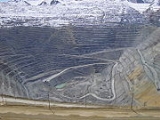
List of National Historic Landmarks in Utah
Encyclopedia
This is a complete List of National Historic Landmarks in Utah. The United States
National Historic Landmark
program is operated under the auspices of the National Park Service
, and recognizes structures, districts, objects, and similar resources according to a list of criteria of national significance. The state
of Utah
is home to 14 of these landmarks, tying together a wide range of historic threads.
The table below lists all 14 of these sites, along with added detail and description.
United States
The United States of America is a federal constitutional republic comprising fifty states and a federal district...
National Historic Landmark
National Historic Landmark
A National Historic Landmark is a building, site, structure, object, or district, that is officially recognized by the United States government for its historical significance...
program is operated under the auspices of the National Park Service
National Park Service
The National Park Service is the U.S. federal agency that manages all national parks, many national monuments, and other conservation and historical properties with various title designations...
, and recognizes structures, districts, objects, and similar resources according to a list of criteria of national significance. The state
U.S. state
A U.S. state is any one of the 50 federated states of the United States of America that share sovereignty with the federal government. Because of this shared sovereignty, an American is a citizen both of the federal entity and of his or her state of domicile. Four states use the official title of...
of Utah
Utah
Utah is a state in the Western United States. It was the 45th state to join the Union, on January 4, 1896. Approximately 80% of Utah's 2,763,885 people live along the Wasatch Front, centering on Salt Lake City. This leaves vast expanses of the state nearly uninhabited, making the population the...
is home to 14 of these landmarks, tying together a wide range of historic threads.
The table below lists all 14 of these sites, along with added detail and description.
| Landmark name | Image | Date listed | Locality | County | Description | |
|---|---|---|---|---|---|---|
| Alkali Ridge Alkali Ridge Alkali Ridge, also known as Alkali Point, is a set of widely-scattered archaeological remains of the earliest forms of Puebloan architecture, representing a period of transition from scattered, pit-style dwellings to a settled agricultural lifestyle... |
image pending | na | San Juan San Juan County, Utah As of the current census of 2010, there were 14,746 people and 4,505 households. The racial and ethnic composition of the population was 50.4% Native American, 45.8% white, 0.3% Asian, 0.2% African American and 2.3% reporting two or more races... |
A set of widely-scattered archaeological Archaeology Archaeology, or archeology , is the study of human society, primarily through the recovery and analysis of the material culture and environmental data that they have left behind, which includes artifacts, architecture, biofacts and cultural landscapes... remains of the earliest forms of Puebloan Ancient Pueblo Peoples Ancient Pueblo People or Ancestral Pueblo peoples were an ancient Native American culture centered on the present-day Four Corners area of the United States, comprising southern Utah, northern Arizona, northwest New Mexico, and southern Colorado... architecture Architecture Architecture is both the process and product of planning, designing and construction. Architectural works, in the material form of buildings, are often perceived as cultural and political symbols and as works of art... , representing a period of transition from scattered, pit-style dwellings to a settled agricultural Agriculture Agriculture is the cultivation of animals, plants, fungi and other life forms for food, fiber, and other products used to sustain life. Agriculture was the key implement in the rise of sedentary human civilization, whereby farming of domesticated species created food surpluses that nurtured the... lifestyle. These multi-story building Building In architecture, construction, engineering, real estate development and technology the word building may refer to one of the following:... s and kiva Kiva A kiva is a room used by modern Puebloans for religious rituals, many of them associated with the kachina belief system. Among the modern Hopi and most other Pueblo peoples, kivas are square-walled and underground, and are used for spiritual ceremonies.... s have yielded high-quality ceramics Pottery Pottery is the material from which the potteryware is made, of which major types include earthenware, stoneware and porcelain. The place where such wares are made is also called a pottery . Pottery also refers to the art or craft of the potter or the manufacture of pottery... , and form the type location for the Pueblo II Pueblo II Era The Pueblo II Era, AD 900 to 1150, was the second pueblo period of the Ancient Pueblo People of the Four Corners region of the American southwest. During this period people lived in dwellings made of stone and mortar, enjoyed communal activities in kivas, built towers and water conversing dams,... period (ca. 10th century - ca. 11th century). |
||
| Bingham Canyon Open Pit Copper Mine Bingham Canyon Mine The Bingham Canyon Mine, also known as the Kennecott Copper Mine, is an open-pit mining operation extracting a large porphyry copper deposit southwest of Salt Lake City, Utah, USA, in the Oquirrh Mountains. It is the deepest open-pit mine in the world. The mine is owned by Rio Tinto Group, an... |
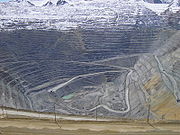 |
40°31′20.5"N 112°8′58.1"W | Salt Lake Salt Lake County, Utah Salt Lake County is a county located in the U.S. state of Utah. It had a population of 1,029,655 at the 2010 census. Its county seat and largest city is Salt Lake City, the state capital. It occupies Salt Lake Valley, as well as parts of the surrounding mountains, the Oquirrh Mountains to the west... |
The world's first and largest open-pit Open-pit mining Open-pit mining or opencast mining refers to a method of extracting rock or minerals from the earth by their removal from an open pit or borrow.... copper Copper Copper is a chemical element with the symbol Cu and atomic number 29. It is a ductile metal with very high thermal and electrical conductivity. Pure copper is soft and malleable; an exposed surface has a reddish-orange tarnish... mine Mining Mining is the extraction of valuable minerals or other geological materials from the earth, from an ore body, vein or seam. The term also includes the removal of soil. Materials recovered by mining include base metals, precious metals, iron, uranium, coal, diamonds, limestone, oil shale, rock... , Bingham Canyon was opened in 1904. |
||
| Bryce Canyon Lodge and Deluxe Cabins Bryce Canyon Lodge Bryce Canyon Lodge is a lodge in Bryce Canyon National Park, Utah. It was built between 1924 and 1925 using local materials. Designed by architect Gilbert Stanley Underwood, the lodge is an excellent example of National Park Service Rustic design... |
 |
Bryce Canyon National Park Bryce Canyon National Park Bryce Canyon National Park is a national park located in southwestern Utah in the United States. The major feature of the park is Bryce Canyon which, despite its name, is not a canyon but a giant natural amphitheater created by erosion along the eastern side of the Paunsaugunt Plateau... 37.6261794603°N 112.166555521°W |
Garfield Garfield County, Utah Garfield County is a county located in the U.S. state of Utah. As of 2000 the population was 4,735. It was named for James A. Garfield, President of the United States in 1881. Its county seat and largest city is Panguitch.-Geography:... |
The Union Pacific Railroad Union Pacific Railroad The Union Pacific Railroad , headquartered in Omaha, Nebraska, is the largest railroad network in the United States. James R. Young is president, CEO and Chairman.... built Construction In the fields of architecture and civil engineering, construction is a process that consists of the building or assembling of infrastructure. Far from being a single activity, large scale construction is a feat of human multitasking... this national park National park A national park is a reserve of natural, semi-natural, or developed land that a sovereign state declares or owns. Although individual nations designate their own national parks differently A national park is a reserve of natural, semi-natural, or developed land that a sovereign state declares or... lodge in 1924-1927. The architectural Architecture Architecture is both the process and product of planning, designing and construction. Architectural works, in the material form of buildings, are often perceived as cultural and political symbols and as works of art... style National Park Service Rustic National Park Service rustic, also colloquially known as Parkitecture, is a style of architecture that arose in the United States National Park System to create buildings that harmonized with their natural environment. Since its founding, the National Park Service consistently has sought to provide... was used by railroads Rail transport Rail transport is a means of conveyance of passengers and goods by way of wheeled vehicles running on rail tracks. In contrast to road transport, where vehicles merely run on a prepared surface, rail vehicles are also directionally guided by the tracks they run on... for lodges across the American west Western United States .The Western United States, commonly referred to as the American West or simply "the West," traditionally refers to the region comprising the westernmost states of the United States. Because the U.S. expanded westward after its founding, the meaning of the West has evolved over time... with the encouragement of the National Park Service National Park Service The National Park Service is the U.S. federal agency that manages all national parks, many national monuments, and other conservation and historical properties with various title designations... . |
||
| Central Utah Relocation Center (Topaz) | na | Millard Millard County, Utah Millard County is a county located in the U.S. state of Utah. In 2010, its population was 12,420. It was named for Millard Fillmore, thirteenth President of the United States. Its county seat is Fillmore and the largest city is Delta.-Geography:... |
One of 10 relocation centers for internment of Japanese Americans Japanese American internment Japanese-American internment was the relocation and internment by the United States government in 1942 of approximately 110,000 Japanese Americans and Japanese who lived along the Pacific coast of the United States to camps called "War Relocation Camps," in the wake of Imperial Japan's attack on... during World War II World War II World War II, or the Second World War , was a global conflict lasting from 1939 to 1945, involving most of the world's nations—including all of the great powers—eventually forming two opposing military alliances: the Allies and the Axis... . The internees were mostly from northern California Northern California Northern California is the northern portion of the U.S. state of California. The San Francisco Bay Area , and Sacramento as well as its metropolitan area are the main population centers... and the San Francisco Bay Area San Francisco Bay Area The San Francisco Bay Area, commonly known as the Bay Area, is a populated region that surrounds the San Francisco and San Pablo estuaries in Northern California. The region encompasses metropolitan areas of San Francisco, Oakland, and San Jose, along with smaller urban and rural areas... , and included many professional artist Artist An artist is a person engaged in one or more of any of a broad spectrum of activities related to creating art, practicing the arts and/or demonstrating an art. The common usage in both everyday speech and academic discourse is a practitioner in the visual arts only... s. |
|||
| Danger Cave Danger Cave Danger Cave is a North American Archaeological site located in the Bonneville Basin of western Utah around the Great Salt Lakes region, that features artifacts of the Desert Culture from ca. 9500 BCE until ca. 500 CE... |
 |
na | Tooele Tooele County, Utah Tooele County is a county located in the U.S. state of Utah. As of 2000, the population was 40,735 and by 2005 was estimated at 51,311. Its county seat and largest city is Tooele.... |
Archaeological site Archaeology Archaeology, or archeology , is the study of human society, primarily through the recovery and analysis of the material culture and environmental data that they have left behind, which includes artifacts, architecture, biofacts and cultural landscapes... featuring artifacts Artifact (archaeology) An artifact or artefact is "something made or given shape by man, such as a tool or a work of art, esp an object of archaeological interest"... of the Desert Culture from ca. 9500 BCE 10th millennium BC The 10th millennium BC marks the beginning of the Mesolithic and Epipaleolithic period, which is the first part of the Holocene epoch. Agriculture, based on the cultivation of primitive forms of millet and rice, occurred in Southwest Asia... until ca. 500 CE 500 Year 500 was a leap year starting on Saturday of the Julian calendar. At the time, it was known as the Year of the Consulship of Patricius and Hypatius... . |
||
| Desolation Canyon Desolation Canyon (Utah) Desolation Canyon is a remote canyon on the Green River in the eastern part of the U.S. state of Utah. It was traversed by John Wesley Powell in 1869 as part of an expedition that was sponsored by the Smithsonian Institution.... |
image pending | na | Carbon Carbon County, Utah Carbon County is a county located in the U.S. state of Utah. Named for the major coal deposits in the area, the county seat and largest city, is Price. Carbon County is the second largest natural gas producer in Utah , with 94 billion cubic feet produced in 2008. As of 2010 the population was... , Emery Emery County, Utah Emery County is a county located in the U.S. state of Utah. As of 2000 the population was 10,860, and by 2009 had been estimated to decrease to 10,629. It was named for George W. Emery, governor of the Utah Territory in 1875... , Grand Grand County, Utah Grand County is a county located in the U.S. state of Utah. As of 2000 the population was 8,485, and by 2005 had been estimated at 8,743. It was named for the Colorado River, which at the time of statehood was known as the Grand River. Its county seat and largest city is Moab.-Geography:According... , and Uintah Uintah County, Utah This page deals with the Utah County. For the Wyoming County, see Uinta County, Wyoming.Uintah County is a county located in the U.S. state of Utah. As of 2000 the population was 25,224 and by 2009 was estimated at 31,536. It was named for the Ute Indians, the tribe that lives in the basin. Its... |
This remote canyon Canyon A canyon or gorge is a deep ravine between cliffs often carved from the landscape by a river. Rivers have a natural tendency to reach a baseline elevation, which is the same elevation as the body of water it will eventually drain into. This forms a canyon. Most canyons were formed by a process of... on the Colorado River Colorado River The Colorado River , is a river in the Southwestern United States and northwestern Mexico, approximately long, draining a part of the arid regions on the western slope of the Rocky Mountains. The watershed of the Colorado River covers in parts of seven U.S. states and two Mexican states... was traversed by John Wesley Powell John Wesley Powell John Wesley Powell was a U.S. soldier, geologist, explorer of the American West, and director of major scientific and cultural institutions... in 1869. Powell's expedition Exploration Exploration is the act of searching or traveling around a terrain for the purpose of discovery of resources or information. Exploration occurs in all non-sessile animal species, including humans... was sponsored by the Smithsonian Institution Smithsonian Institution The Smithsonian Institution is an educational and research institute and associated museum complex, administered and funded by the government of the United States and by funds from its endowment, contributions, and profits from its retail operations, concessions, licensing activities, and magazines... . |
||
| Emigration Canyon Emigration Canyon Emigration Canyon is a CDP, township and canyon in Salt Lake County, Utah, United States, located east of Salt Lake City in the Wasatch Range. Beginning at the southern end of the University of Utah, the canyon itself heads east and northeast between Salt Lake City and Morgan County. The boundaries... |
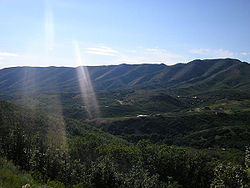 |
Salt Lake City Salt Lake City, Utah Salt Lake City is the capital and the most populous city of the U.S. state of Utah. The name of the city is often shortened to Salt Lake or SLC. With a population of 186,440 as of the 2010 Census, the city lies in the Salt Lake City metropolitan area, which has a total population of 1,124,197... |
Salt Lake Salt Lake County, Utah Salt Lake County is a county located in the U.S. state of Utah. It had a population of 1,029,655 at the 2010 census. Its county seat and largest city is Salt Lake City, the state capital. It occupies Salt Lake Valley, as well as parts of the surrounding mountains, the Oquirrh Mountains to the west... |
The Mormon pioneers traversed the Wasatch Range Wasatch Range The Wasatch Range is a mountain range that stretches approximately from the Utah-Idaho border, south through central Utah in the western United States. It is generally considered the western edge of the greater Rocky Mountains, and the eastern edge of the Great Basin region... through this canyon Canyon A canyon or gorge is a deep ravine between cliffs often carved from the landscape by a river. Rivers have a natural tendency to reach a baseline elevation, which is the same elevation as the body of water it will eventually drain into. This forms a canyon. Most canyons were formed by a process of... at the western end of their trail Mormon Trail The Mormon Trail or Mormon Pioneer Trail is the 1,300 mile route that members of The Church of Jesus Christ of Latter-day Saints traveled from 1846 to 1868... , beginning in 1847. The canyon mouth is the location of Brigham Young Brigham Young Brigham Young was an American leader in the Latter Day Saint movement and a settler of the Western United States. He was the President of The Church of Jesus Christ of Latter-day Saints from 1847 until his death in 1877, he founded Salt Lake City, and he served as the first governor of the Utah... 's famous quotation "This is the place." |
||
| Fort Douglas | 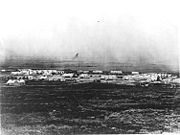 |
Salt Lake City Salt Lake City, Utah Salt Lake City is the capital and the most populous city of the U.S. state of Utah. The name of the city is often shortened to Salt Lake or SLC. With a population of 186,440 as of the 2010 Census, the city lies in the Salt Lake City metropolitan area, which has a total population of 1,124,197... 40°45′52.8"N 111°50′1.4"W |
Salt Lake Salt Lake County, Utah Salt Lake County is a county located in the U.S. state of Utah. It had a population of 1,029,655 at the 2010 census. Its county seat and largest city is Salt Lake City, the state capital. It occupies Salt Lake Valley, as well as parts of the surrounding mountains, the Oquirrh Mountains to the west... |
This US Army United States Army The United States Army is the main branch of the United States Armed Forces responsible for land-based military operations. It is the largest and oldest established branch of the U.S. military, and is one of seven U.S. uniformed services... post was established in the 1860s to uphold United States United States The United States of America is a federal constitutional republic comprising fifty states and a federal district... authority in the Mormon Mormon The term Mormon most commonly denotes an adherent, practitioner, follower, or constituent of Mormonism, which is the largest branch of the Latter Day Saint movement in restorationist Christianity... territories, and to protect overland transport Transport Transport or transportation is the movement of people, cattle, animals and goods from one location to another. Modes of transport include air, rail, road, water, cable, pipeline, and space. The field can be divided into infrastructure, vehicles, and operations... ation and communication Communication Communication is the activity of conveying meaningful information. Communication requires a sender, a message, and an intended recipient, although the receiver need not be present or aware of the sender's intent to communicate at the time of communication; thus communication can occur across vast... lines. |
||
| Mountain Meadows Massacre Site Mountain Meadows massacre The Mountain Meadows massacre was a series of attacks on the Baker–Fancher emigrant wagon train, at Mountain Meadows in southern Utah. The attacks culminated on September 11, 1857 in the mass slaughter of the emigrant party by the Iron County district of the Utah Territorial Militia and some local... |
Central Central, Utah Central is a census-designated place in northwestern Washington County, Utah, United States, on the edge of the Dixie National Forest. The population was 613 at the 2010 census. Central lies along State Route 18 north of the city of St. George, the county seat of Washington County... |
Washington Washington County, Utah As of the census of 2000, there were 90,354 people, 29,939 households, and 23,442 families residing in the county. The population density was 37 people per square mile . There were 36,478 housing units at an average density of 15 per square mile... |
||||
| Old City Hall Salt Lake City Council Hall The Salt Lake City Council Hall is currently home to offices for the Utah Office of Tourism and The Utah Film Commission and is located on Capitol Hill in Salt Lake City, Utah... |
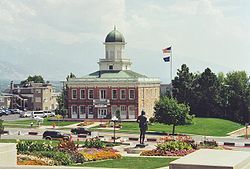 |
Salt Lake City Salt Lake City, Utah Salt Lake City is the capital and the most populous city of the U.S. state of Utah. The name of the city is often shortened to Salt Lake or SLC. With a population of 186,440 as of the 2010 Census, the city lies in the Salt Lake City metropolitan area, which has a total population of 1,124,197... 40.7739307176°N 111.886848256°W |
Salt Lake Salt Lake County, Utah Salt Lake County is a county located in the U.S. state of Utah. It had a population of 1,029,655 at the 2010 census. Its county seat and largest city is Salt Lake City, the state capital. It occupies Salt Lake Valley, as well as parts of the surrounding mountains, the Oquirrh Mountains to the west... |
Completed in 1866, the city hall also served as the capitol of the Utah Territory Utah Territory The Territory of Utah was an organized incorporated territory of the United States that existed from September 9, 1850, until January 4, 1896, when the final extent of the territory was admitted to the Union as the State of Utah.... , and was the scene of many tensions between Mormon Mormon The term Mormon most commonly denotes an adherent, practitioner, follower, or constituent of Mormonism, which is the largest branch of the Latter Day Saint movement in restorationist Christianity... leaders and the United States United States The United States of America is a federal constitutional republic comprising fifty states and a federal district... . |
||
| Quarry Visitor Center Quarry Visitor Center Quarry Visitor Center, in Dinosaur National Monument in Utah was built as part of the National Park Service's Mission 66 program of modern architectural design in the US national parks. This visitor center exemplifies the philosophy of locating visitor facilities immediately at the resource being... |
Dinosaur National Monument Dinosaur National Monument Dinosaur National Monument is a National Monument located on the southeast flank of the Uinta Mountains on the border between Colorado and Utah at the confluence of the Green and Yampa Rivers. Although most of the monument area is in Moffat County, Colorado, the Dinosaur Quarry is located in Utah... 40°26′25.6"N 109°18′4.5"W |
Uintah Uintah County, Utah This page deals with the Utah County. For the Wyoming County, see Uinta County, Wyoming.Uintah County is a county located in the U.S. state of Utah. As of 2000 the population was 25,224 and by 2009 was estimated at 31,536. It was named for the Ute Indians, the tribe that lives in the basin. Its... |
Built Construction In the fields of architecture and civil engineering, construction is a process that consists of the building or assembling of infrastructure. Far from being a single activity, large scale construction is a feat of human multitasking... as part of the National Park Service National Park Service The National Park Service is the U.S. federal agency that manages all national parks, many national monuments, and other conservation and historical properties with various title designations... 's Mission 66 Mission 66 Mission 66 was a US National Park Service ten-year program that was intended to dramatically expand Park Service visitor services by 1966, in time for the 50th anniversary of the establishment of the Park Service.... program of modern architectural design Modern architecture Modern architecture is generally characterized by simplification of form and creation of ornament from the structure and theme of the building. It is a term applied to an overarching movement, with its exact definition and scope varying widely... in the US United States The United States of America is a federal constitutional republic comprising fifty states and a federal district... national park National park A national park is a reserve of natural, semi-natural, or developed land that a sovereign state declares or owns. Although individual nations designate their own national parks differently A national park is a reserve of natural, semi-natural, or developed land that a sovereign state declares or... s, this visitor center Visitor center A visitor center or centre , visitor information center, tourist information center, is a physical location that provides tourist information to the visitors who tour the place or area locally... exemplifies the philosophy of locating visitor facilities immediately at the resource being interpreted. The visitor center is presently closed due to structural damage Structural failure Structural failure refers to loss of the load-carrying capacity of a component or member within a structure or of the structure itself. Structural failure is initiated when the material is stressed to its strength limit, thus causing fracture or excessive deformations... from unstable soils, and its future is in doubt. |
|||
| Reed O. Smoot House Reed O. Smoot House The Reed O. Smoot House, also known as Mrs. Harlow E. Smoot House, was the home of Reed Smoot from 1892 to his death in 1941, and is located at 183 E. 100 South, Provo, Utah... |
 |
Provo Provo, Utah Provo is the third largest city in the U.S. state of Utah, located about south of Salt Lake City along the Wasatch Front. Provo is the county seat of Utah County and lies between the cities of Orem to the north and Springville to the south... 40.232339°N 111.655529°W |
Utah Utah County, Utah Utah County is a county located in the U.S. state of Utah. As of 2000, the population was 368,536 and by 2008 was estimated at 530,837. It was named for the Spanish name for the Ute Indians. The county seat and largest city is Provo... |
The home Home A home is a place of residence or refuge. When it refers to a building, it is usually a place in which an individual or a family can rest and store personal property. Most modern-day households contain sanitary facilities and a means of preparing food. Animals have their own homes as well, either... of Reed Smoot from 1892 to his death Death Death is the permanent termination of the biological functions that sustain a living organism. Phenomena which commonly bring about death include old age, predation, malnutrition, disease, and accidents or trauma resulting in terminal injury.... in 1941. Smoot was a prominent US Senator United States Senate The United States Senate is the upper house of the bicameral legislature of the United States, and together with the United States House of Representatives comprises the United States Congress. The composition and powers of the Senate are established in Article One of the U.S. Constitution. Each... best known for advocacy of protectionism Protectionism Protectionism is the economic policy of restraining trade between states through methods such as tariffs on imported goods, restrictive quotas, and a variety of other government regulations designed to allow "fair competition" between imports and goods and services produced domestically.This... and the Hawley-Smoot Tariff Smoot-Hawley Tariff Act The Tariff Act of 1930, otherwise known as the Smoot–Hawley Tariff was an act, sponsored by United States Senator Reed Smoot and Representative Willis C. Hawley, and signed into law on June 17, 1930, that raised U.S. tariffs on over 20,000 imported goods to record levels.The overall level tariffs... . |
||
| Temple Square Temple Square Temple Square is a ten acre complex located in the center of Salt Lake City, Utah, owned by The Church of Jesus Christ of Latter-day Saints . In recent years, the usage of the name has gradually changed to include several other church facilities immediately adjacent to Temple Square... |
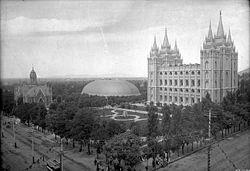 |
Salt Lake City Salt Lake City, Utah Salt Lake City is the capital and the most populous city of the U.S. state of Utah. The name of the city is often shortened to Salt Lake or SLC. With a population of 186,440 as of the 2010 Census, the city lies in the Salt Lake City metropolitan area, which has a total population of 1,124,197... 40°46′12.3"N 111°53′33.6"W |
Salt Lake Salt Lake County, Utah Salt Lake County is a county located in the U.S. state of Utah. It had a population of 1,029,655 at the 2010 census. Its county seat and largest city is Salt Lake City, the state capital. It occupies Salt Lake Valley, as well as parts of the surrounding mountains, the Oquirrh Mountains to the west... |
The earthly center of The Church of Jesus Christ of Latter-day Saints. Begun in the mid-19th century, the Square's Mormon Mormon The term Mormon most commonly denotes an adherent, practitioner, follower, or constituent of Mormonism, which is the largest branch of the Latter Day Saint movement in restorationist Christianity... landmarks include the Salt Lake Temple Salt Lake Temple The Salt Lake Temple is the largest and best-known of more than 130 temples of The Church of Jesus Christ of Latter-day Saints. It is the sixth temple built by the church, requiring 40 years to complete, and the fourth operating temple built since the Mormon exodus from Nauvoo,... , the Tabernacle Salt Lake Tabernacle The Salt Lake Tabernacle, also known as the Mormon Tabernacle, is located on Temple Square in Salt Lake City, Utah along with the Salt Lake Assembly Hall and Salt Lake Temple.-History:... , and the Assembly Hall Salt Lake Assembly Hall thumb|200px|right|Front entrance to the Assembly Hall with the [[Seagull Monument]] in foregroundthumb|200px|right|Inside Assembly HallThe Salt Lake Assembly Hall is one of the buildings owned by The Church of Jesus Christ of Latter-day Saints on the southwest corner of Temple Square in Salt Lake... . |
||
| Brigham Young Complex Brigham Young Complex The Brigham Young Complex is the collective name given in the U.S. National Historic Landmark program to a set of two houses in Salt Lake City, Utah. These houses were the residence of Brigham Young from 1852 until his death in 1877... |
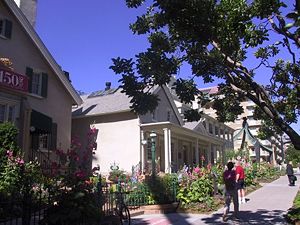 |
Salt Lake City Salt Lake City, Utah Salt Lake City is the capital and the most populous city of the U.S. state of Utah. The name of the city is often shortened to Salt Lake or SLC. With a population of 186,440 as of the 2010 Census, the city lies in the Salt Lake City metropolitan area, which has a total population of 1,124,197... 40.7677064209°N 111.887950365°W |
Salt Lake Salt Lake County, Utah Salt Lake County is a county located in the U.S. state of Utah. It had a population of 1,029,655 at the 2010 census. Its county seat and largest city is Salt Lake City, the state capital. It occupies Salt Lake Valley, as well as parts of the surrounding mountains, the Oquirrh Mountains to the west... |
The Beehive House Beehive House The Beehive House is one of the two official residences of Brigham Young, an early leader of The Church of Jesus Christ of Latter-day Saints . The Beehive House gets its name from the Beehive sculpture atop the house. It was designed by Young's brother-in-law and architect of the Salt Lake... and adjacent Lion House were the residence of Brigham Young Brigham Young Brigham Young was an American leader in the Latter Day Saint movement and a settler of the Western United States. He was the President of The Church of Jesus Christ of Latter-day Saints from 1847 until his death in 1877, he founded Salt Lake City, and he served as the first governor of the Utah... from 1852 until his death Death Death is the permanent termination of the biological functions that sustain a living organism. Phenomena which commonly bring about death include old age, predation, malnutrition, disease, and accidents or trauma resulting in terminal injury.... in 1877. As President of The Church of Jesus Christ of Latter-day Saints at the time of the Mormon Mormon The term Mormon most commonly denotes an adherent, practitioner, follower, or constituent of Mormonism, which is the largest branch of the Latter Day Saint movement in restorationist Christianity... settlement of the Salt Lake Valley Salt Lake Valley Salt Lake Valley is a valley in Salt Lake County in the north-central portion of the U.S. state of Utah. It contains Salt Lake City and many of its suburbs, notably West Valley City, Murray, Sandy, and West Jordan; its total population is 1,029,655 as of 2010... , Young and his home were pivotal in the development of the Church, Utah Utah Utah is a state in the Western United States. It was the 45th state to join the Union, on January 4, 1896. Approximately 80% of Utah's 2,763,885 people live along the Wasatch Front, centering on Salt Lake City. This leaves vast expanses of the state nearly uninhabited, making the population the... , and the American west Western United States .The Western United States, commonly referred to as the American West or simply "the West," traditionally refers to the region comprising the westernmost states of the United States. Because the U.S. expanded westward after its founding, the meaning of the West has evolved over time... . |
See also
- List of U.S. National Historic Landmarks by state
- List of Registered Historic Places in Utah
- Historic preservationHistoric preservationHistoric preservation is an endeavor that seeks to preserve, conserve and protect buildings, objects, landscapes or other artifacts of historical significance...
- National Register of Historic PlacesNational Register of Historic PlacesThe National Register of Historic Places is the United States government's official list of districts, sites, buildings, structures, and objects deemed worthy of preservation...
- History of UtahHistory of UtahThe history of Utah is an examination of the human history and social activity within the state of Utah located in the western United States.- Early people :...
External links
- National Historic Landmark Program at the National Park ServiceNational Park ServiceThe National Park Service is the U.S. federal agency that manages all national parks, many national monuments, and other conservation and historical properties with various title designations...
- Lists of National Historic Landmarks

